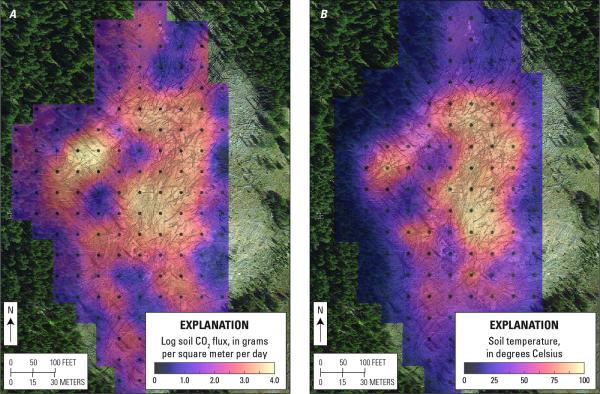Editor’s note: Yellowstone Caldera Chronicles is a weekly column written by scientists and collaborators of the Yellowstone Volcano Observatory. This week’s contribution is from Michael Poland, geophysicist with the U.S. Geological Survey and Scientist-in-Charge of the Yellowstone Volcano Observatory.
Magma contains dissolved gases that are released as the magma ascends and pressure decreases. This is akin to how bubbles come out of a soda when it is opened. Different types of gases come out of the magma at different pressures; therefore, monitoring gas compositions and amounts can provide information about the depth, characteristics, and amounts of magma beneath the surface.
Some gases are relatively easy to measure, like sulfur dioxide (SO2). SO2 is not present in “clean” atmosphere to any significant degree, so SO2 that is detected near a volcano is most likely volcanic in origin (assuming there are no nearby power plants that are emitting the gas). And because SO2 only comes out of magma when it is at shallow levels and is only detected when there is no groundwater between the magma and the surface, if you are seeing SO2 coming from a volcano, it can mean that magma is close to the surface and all of the groundwater has been driven away.
SO2 has never been detected at Yellowstone, which is not surprising—the magma reservoir is too deep to emit significant amounts of the gas, and what small amounts are released would be chemically “scrubbed” by water in the hydrothermal system. There is a lot of hydrogen sulfide—H2S—coming from thermal areas in Yellowstone, but that is a normal product of a shallow hydrothermal system.
Volcanoes also emit carbon dioxide (CO2). An important point to make right off the bat is that human emissions of CO2 dwarf those of volcanoes. Globally, it is calculated that all volcanic emissions, including from eruptions and also from “diffuse” sources at non-erupting volcanoes, total about 820,000 metric tons (1 metric ton = 1.1 US tons, so that’s about 904,000 US tons) of CO2 per day. Human activities release about 111,000,000 metric tons (122,000,000 US tons) of CO2 per day. So, volcanoes emit only about 1% the amount of CO2 that humans do on a daily basis.
Some volcanoes emit more CO2 than others. For example, frequently active volcanoes like Etna (Italy), Bagana (Papua New Guinea), and Kīlauea (Hawaiʻi) each can emit thousands of metric tons of CO2 per day. Lassen Peak (California), on the other hand, emits less than 100 metric tons (110 US tons) of CO2 per day.
For volcanoes that are erupting, CO2 can be measured by determining the excess in the eruptive plume compared to background levels. This is a relatively straightforward measurement because the gas plume is easy to identify, although still a challenge due to the background CO2 already present in the atmosphere. Many non-erupting volcanoes have obvious craters or vents where gas emissions are still comparatively easy to measure. For some volcanoes that are not erupting and lack obvious emission sources, like Yellowstone, the measurement is more challenging. There, the magma chamber is miles deep, tens of miles wide, and lies beneath the shallower hydrothermal areas and their heated groundwater. Any rising magmatic gas percolates through the hydrothermal reservoirs, cools, and reacts chemically, and gas can be emitted over a very broad area.
Gas flux measurement being taken over altered ground at Brimstone Basin, Yellowstone.
So, how do you determine CO2 emission rates from Yellowstone, where there is no obvious plume, and where numerous degassing areas are spread over an area twice the size of the state of Rhode Island? Geochemists overcame the issue by measuring soil CO2 emissions from different types of ground, including travertine areas (like those at Mammoth Hot Springs), neutral-chloride spring areas (like those near Old Faithful), and both warm and cold acid-sulfate areas (typified by Mud Volcano). By determining the emissions from lots of these types of areas and then extrapolating over the amount of that type of ground present in the region, the overall CO2 emission rate from the Yellowstone system can be calculated.
These measurements found that neutral-chloride areas, which host the most well-known geysers and hot springs, like Old Faithful and Grand Prismatic Spring, emit very little CO2. Travertine areas release slightly more, but both are only a fraction of what is released through acid-sulfate thermal areas.
It is not just thermally active areas that emit CO2; cool, thermally inactive acid-sulfate areas that used to be warm also emit the gas. Brimstone Basin, on the southeast side of Yellowstone Lake, is a good example. There, the ground is chalky and altered, having been turned into clay by acid gases, but the surface is cool; nevertheless, the area emits comparable amounts of CO2 per unit of area as warm thermal regions, like Mud Volcano.
In contrast, some young acid-sulfate thermal areas don’t release that much CO2. The new thermal area near Tern Lake, which formed over the past 2 decades, releases only about half as much CO2per unit of area compared to the more mature Mud Volcano region.

Soil carbon dioxide concentration and temperature measured at a new thermal area near Tern Lake in Yellowstone National Park on the east side of Yellowstone Caldera. A, Map of soil carbon dioxide flux simulated based on measurements made at the black dots in September 2022. B, Map of soil temperature at a depth of 20 centimeters (8 inches).
When you add up all the sources and adjust for the amount of various types of ground cover, the estimated CO2 emission rate at Yellowstone is 24,000 metric tons per day (26,000 US tons) per day. There is a lot of uncertainty in this measurement—perhaps as much as 50 percent—given the extrapolations. It is also uncertain just how much of this CO2 is strictly magmatic, since CO2 can also be released by heating of subsurface limestone rocks, which contain a lot of carbon.
But even considering the large uncertainty, this still puts Yellowstone among the most significant sources of volcanic CO2 on Earth, higher than many frequently erupting volcanoes (including Kīlauea) and capable of causing animal deaths under certain conditions, although it still pales in comparison to human emissions (Yellowstone emissions are only about 10 percent of those from New York City).
Of course, this is Yellowstone we’re talking about. Home to more geysers than any other place in the world, the first national park, and a wonderland for biology, geology, and ecology. Would you expect anything less?
FURTHER READING
Global CO2 emissions:
Volcanic CO2 emissions:
Yellowstone CO2 emissions:





